|
Monday 23rd. May 2016
It was a cool and sunny morning when we got on the bus and
headed off to Pont du Gard.
The Pont du Gard is a Roman monument built halfway through the
1st century AD. It is the principal construction in a 50 km long
aqueduct that supplied the city of Nîmes, formerly known as
Nemausus, with water. Built as a three-level aqueduct standing
50 m high, it allowed water to flow across the Gardon river.
In essence, the bridge is constructed out of soft yellow
limestone blocks, taken from a nearby quarry that borders the
river. The highest part of the structure is made out of breeze
blocks joined together with mortar. It is topped by a device
designed to bear the water channel, whose stone slabs are
covered with calcium deposits.
In designing this three-storey bridge, which measures 360 m at
its longest point along the top, the Roman architects and
hydraulic engineers created a technical masterpiece that stands
today as a work of art.
It is 250 metres long and 50 metres high.
|
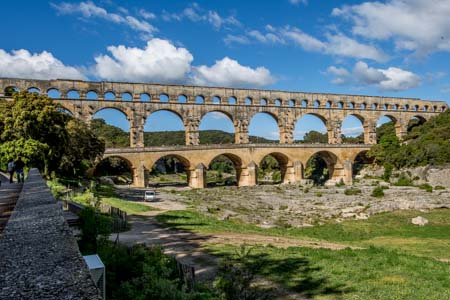
The Pont du Gard |
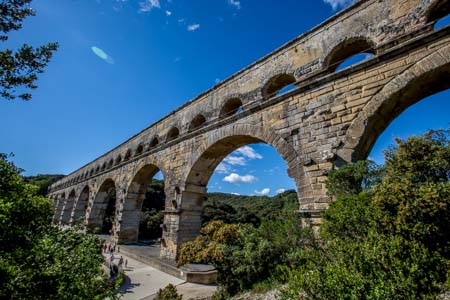
The Pont du Gard |
|
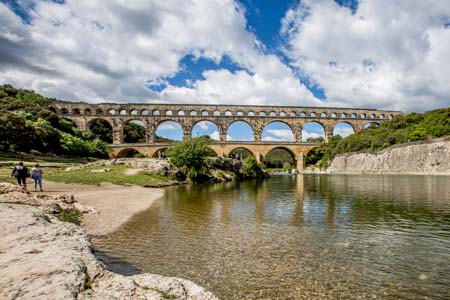
The Pont du Gard |

The Pont du Gard |
At about 11:30 we headed back to Avignon for lunch and then a
look at the Papal Palace.
Avignon became the home of the popes in 1309, who were
fleeing the violent chaos of Rome. The Palais was built between
1335 and 1364 on a natural rocky outcrop at the northern edge of
Avignon, overlooking the river Rhône. The site was formerly
occupied by the old episcopal palace of the bishops of Avignon.
The Palais des Papes was built in two main phases with two
distinct segments, known as the Palais Vieux (Old Palace) and
Palais Neuf (New Palace). By the time of its completion, it
occupied an area of 2.6 acres. The building was enormously
expensive, consuming much of the papacy's income during its
construction.
The Palais was subsequently taken over by the Napoleonic French
state for use as a military barracks and prison. Although it was
further damaged by the military occupation – the frescos were
covered over and largely destroyed – ironically this ensured the
building's physical survival. It was only vacated in 1906, when
it became a national museum. It has been under virtually
constant restoration ever since.
|
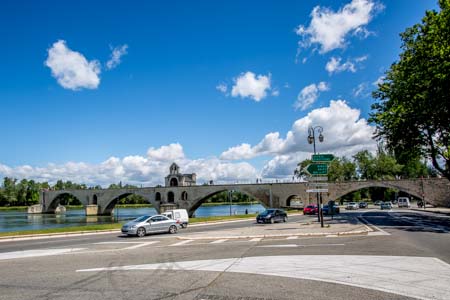
"Sur le pont D'Avignon ..." |
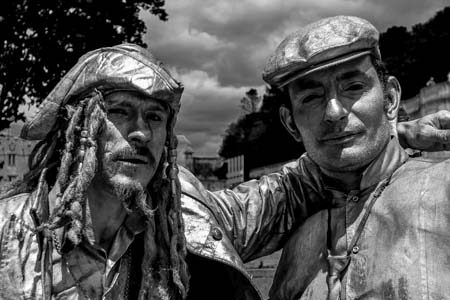
Two silver painted street performers, Avignon |
|
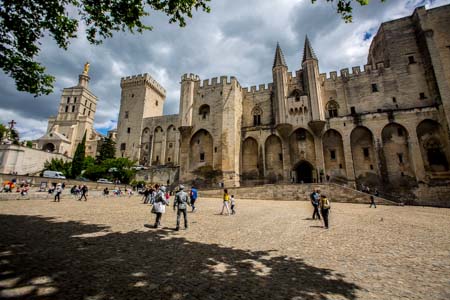
Palais des Papes, Avignon |
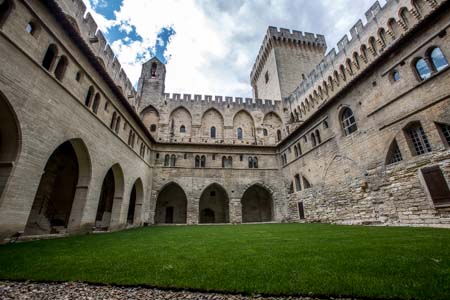
Palais des Papes, Avignon |
Tuesday 24th.
May 2016
It was a fine cool sunny morning and we set off for the city of
Nîmes. The journey took a little over an hour. Fernando took us
on a short walking tour that ended up at the Arena. The
building encloses an elliptical central space 133 m long by 101
m wide. It is ringed by 34 rows of seats supported by a vaulted
construction. It has a capacity of 16,300 spectators and since
1989 has a movable cover and a heating system. Unfortunately
when we visited the interior it was covered in scaffolding and
they were erecting a sound stage right in the middle.
We went past the "Square House" (Maison Carrée) a temple built
by the Romans in about 4-7AD.
Veterans of the Roman legions who had served Julius Caesar in
his Nile campaigns, at the end of fifteen years of soldiering,
were given plots of land to cultivate on the plain of Nîmes.
Throughout the city, small physical remains of Roman Nîmes
testify to its former importance. In modern day
Nîmes this manifest themselves as
small brass plaques in the pavement bearing the city's
emblem — a crocodile tied to a palm tree — a reminder that Nîmes
was a favorite retirement home for Roman officers who conquered
Egypt. (The crocodile is Egypt, and the palm tree symbolizes
victory.)
|
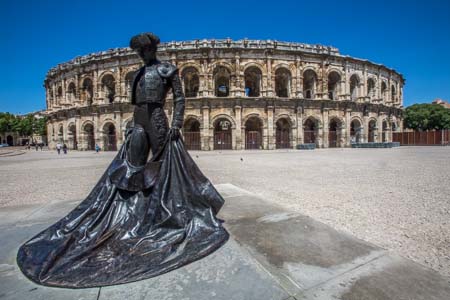
The statue of the
matador outside the Arena,
Nîmes |
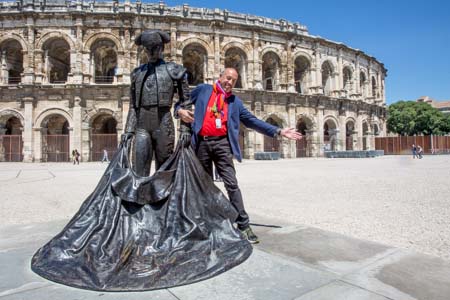
The Matador with his "apprentice," Fernando,
Nîmes |
|
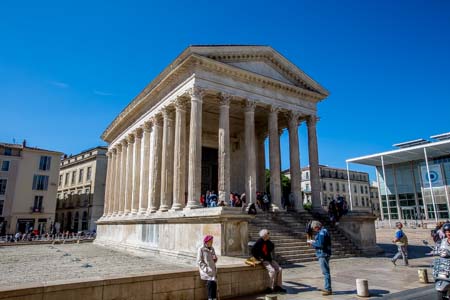
The "Square House," Nîmes |

This area was the site of the old Roman baths,
Nîmes |
We then traveled on to the city of Carcassone. This is a
beautiful, tiny hilltop walled town.
Hilltop Carcassonne, in southern France’s Languedoc region, is a
medieval citadel famous for its 53 watchtowers and double-walled
fortifications. The first walls of the upper town, Le Cité, were
built in Gallo-Roman times; major additions were made in the
13th and 14th centuries. Château Comtal, a 12th-century fortress
within Le Cité, offers archaeological exhibits and a tour of the
inner ramparts.
We had a couple of Grand Marnier Crepes (€3each)
for dinner and checked into our hotel, Les Trois Couronnes.
|
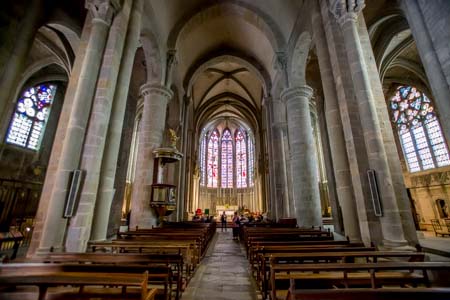
Basilica of St Nazaire, Carcassonne |
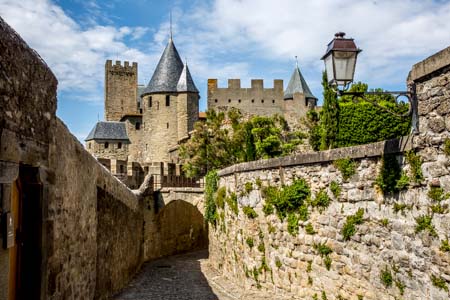
Chateau Comtal, Carcassonne |
|
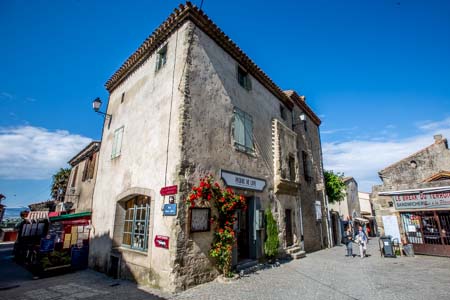
The streets of Carcassonne |
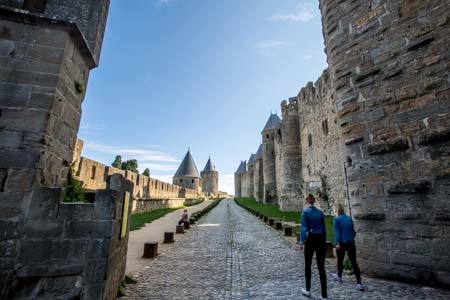
The double walled ramparts of Carcassonne |
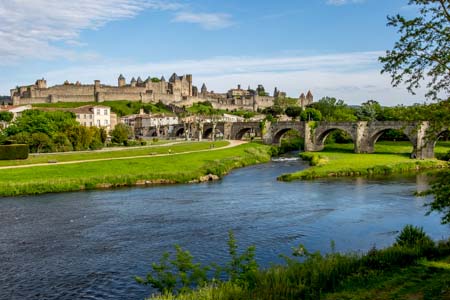
The River Aude, and the walled town of Carcassonne |
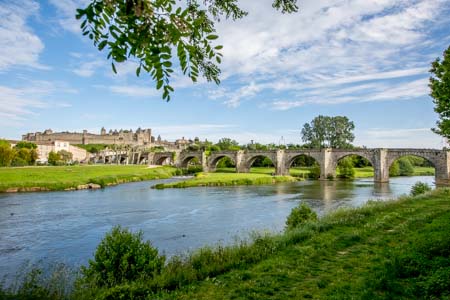
The River Aude, and the
walled town of Carcassonne |
Wednesday 25th.
May 2016
We left the hotel in the big black Volvo bus just before 9:00am
and headed south back into Spain and out of France where there
are fuel strikes and most of the service stations have run out
of diesel. In Spain they have diesel at about
€1.11 per litre opposed to
France, who don't seem to have any, or will sell a bus 50 litres,
where it is about
€1.41 per litre.
We arrive in Barcelona at about 1:00pm. It is 21˚C
here and sunny. We are spending our last two nights in the HCC
Taber Hotel just a short distance from the Ramblas.
We then went on a bus tour of the city. We began by visiting the
Olympic games site which overlooks the city and the port. We
then visited the hospital Sant Pau and finally Antoni
Gaudí's work at Park Güell. We then had dinner at a restaurant
just around the corner from the hotel.
|
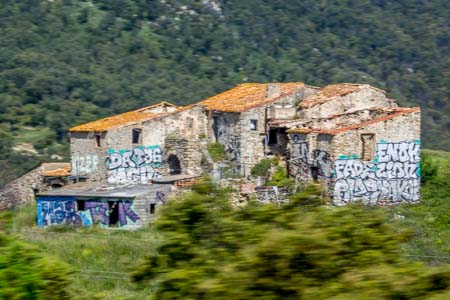
Spanish rural building on the way to Barcelona |

Park Güell, Barcelona |
|
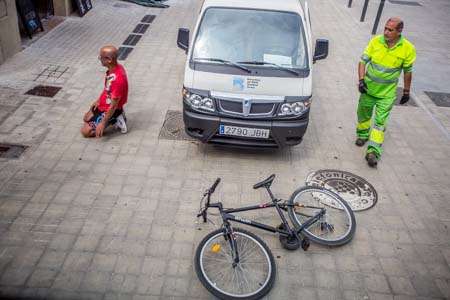
This cyclist fell off in front of an oncoming van,
Barcelona |
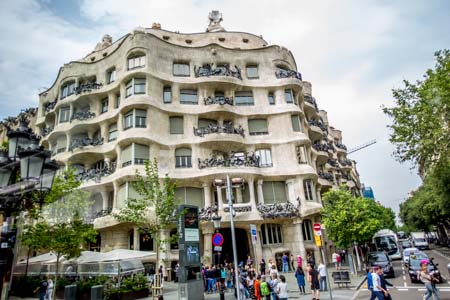
Casa Mila, Barcelona |
|

Park Güell, Barcelona |

Park Güell, Barcelona |
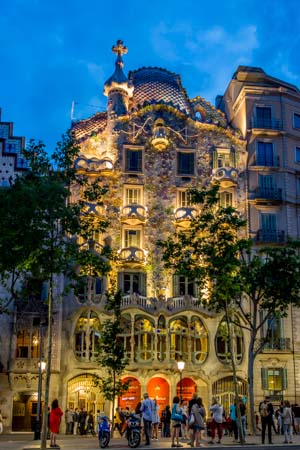
Casa Batlló, Barcelona |
|
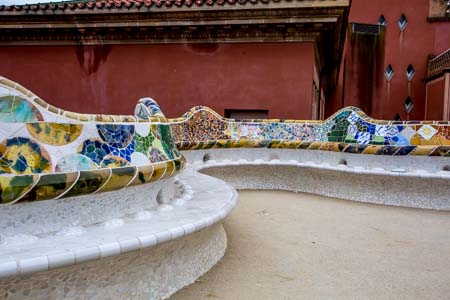
Seats in Park Güell, Barcelona |
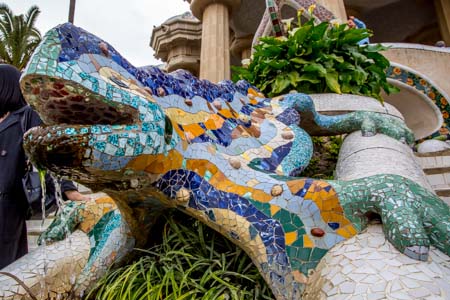
The Chameleon in Park Güell,
Barcelona |
After dinner I took some photos of Casa Batlló which is
another of Gaudi's design. Thursday
26th. May 2016
We left the hotel at about 9:00am on the big black bus with a
new local guide, Anna. She took us to Placa de Catalunya where
we got off the bus and walked down La Rambla, we had a
quick visit to the Mercat (market) de Sant Josep de la
Boqueria, often simply referred to as La Boqueria
and then turned left into the old quarter of the city. We walked
the narrow streets and visited the Cathedral of Santa Eulalia.
As today is Corpus Christi, the local tradition is to put an egg
on top of the water spout on the fountain. It rotates and is
suspended on top of the flow (Refer Bernoulli's theorem).
|
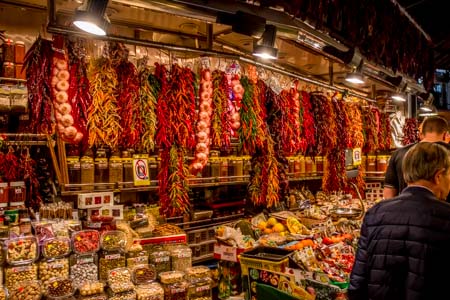
Inside St. Joseph's Market, Barcelona |
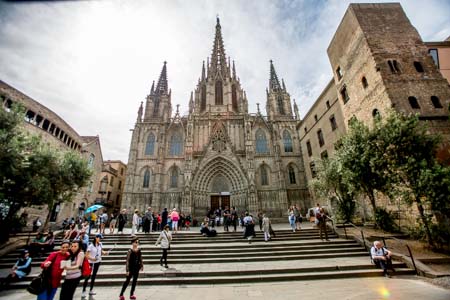
Front of Cathedral of Santa
Eulalia, Barcelona |
|
|
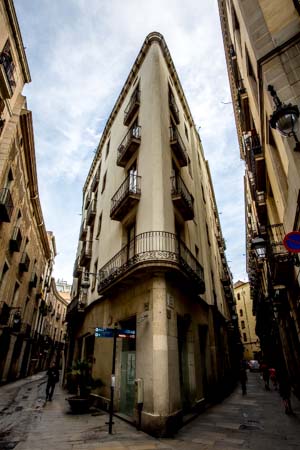
Street in the old part of Barcelona |
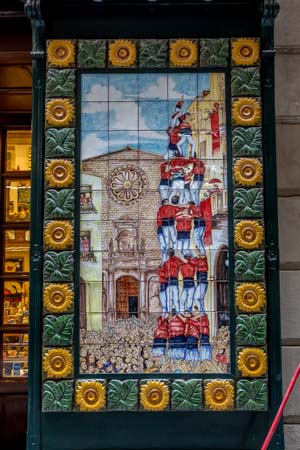
Mosaic of a local tradition, Barcelona |
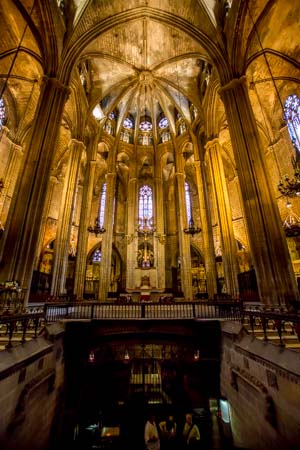
Inside Cathedral of Santa
Eulalia |
We then returned to the bus and drove to the Sagrada
Família. Gaudi became invovled in 1883, a year after
construction began. It is hoped it will be completed by 2026.
This is a basilica as apparently you are not allowed to have two
Cathedrals of the same denomination in the same city, and
Bacelona already had a cathedral. We took photos of the outside
and then had a guided tour of the interior.
|
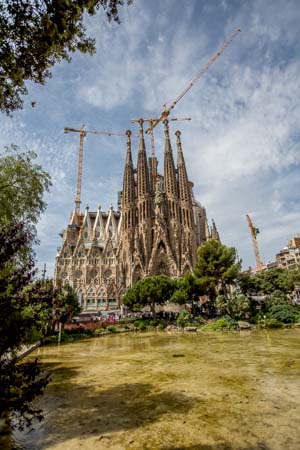
Sagrada Família, Barcelona |
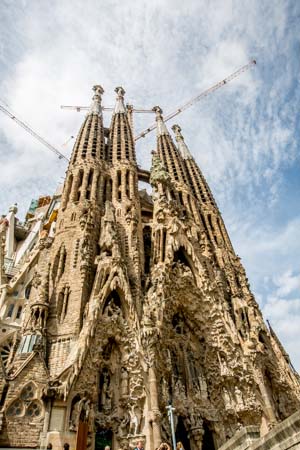
Sagrada Família, Barcelona |

Sagrada Família, Barcelona |
|
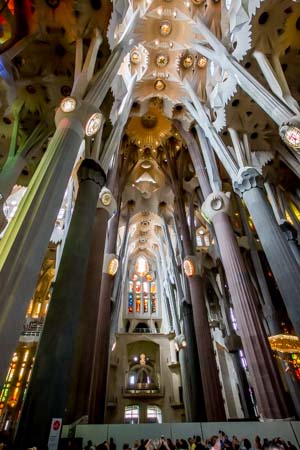
Sagrada Família, Barcelona |
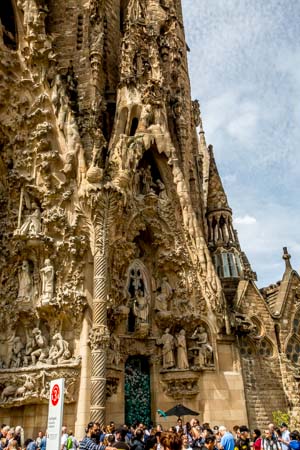
Sagrada Família, Barcelona |
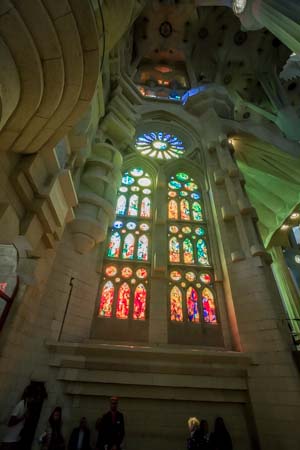
Sagrada Família, Barcelona |
It is just as spectacular as it was the last time we saw it
about three years ago.
We had lunch and then returned to La Rambla for a look around.
In the evening we had our final dinner in a local restaurant not
far from the hotel. Friday
27th. May 2016
We were picked up at the hotel lobby by taxi and taken to the
airport at 11:00am for our 2:00pm Lufthansa flight to Frankfurt
and then on to JFK Airport in the USA. Arrival time in the USA
is about 8:00pm. We will pick up our hire car at the airport and
head to our motel for the night, Ardsley Acres Hotel Court,
about an hour's drive from the Airport. But that will depend on
traffic delays due to roadworks and the fact that it is a public
holiday long weekend in this part of the USA. |